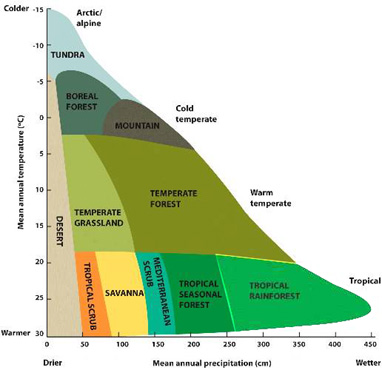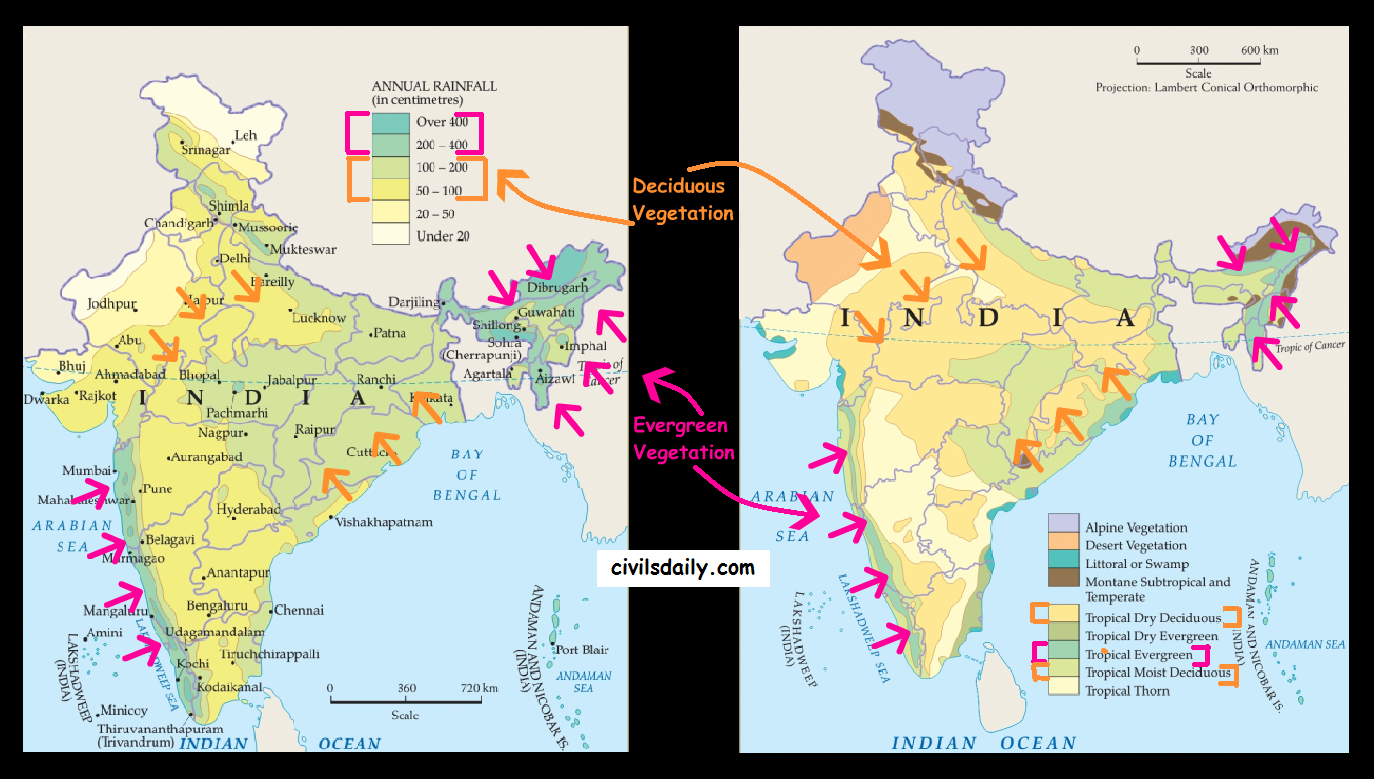Before we discuss the natural vegetation types found in India, let’s get acquainted with some basic terms:
Flora, Vegetation and Forests:
Flora refers to plants of a particular region or period, listed as a species and considered as a group. Likewise, fauna refers to the animal life, considered collectively, of any given period, environment or region.
Vegetation, on the other hand, refers to the assemblage of plant species in a given environmental frame or ecological frame. It is broader than the term flora which refers to species composition. Further:
- Natural vegetation includes that part of the plant life which grows in wild without human aid and adapts to constraints of the natural environment in size, structure and requirements. Thus cultivated crops and fruit orchards form a part of the vegetation but not natural vegetation.
- That part of natural vegetation which has remained undisturbed by humans is referred to as virgin vegetation. It can be found in India in the inaccessible parts of the Himalayas, the Thar Desert and the Sunderbans. Elsewhere, human occupation has either transformed natural vegetation into cultivated vegetation or degraded the natural vegetation.
- The virgin vegetation, which is purely Indian is known as endemic or indigenous species but that which has come from outside India is termed as exotic.
Forest: The term forest implies ‘natural vegetation’ of the area, existing from thousands of years and supporting a variety of biodiversity, forming a complex ecosystem.
Depending on the physical, geographical, climatic and ecological factors, there are different types of forests like evergreen forest (mainly composed of evergreen tree species i.e. species having leaves all throughout the year) and deciduous forest (mainly composed of deciduous tree species i.e. species which lose their leaves during particular months of the year). Each forest type forms a habitat for a specific community of animals that are adapted to live in it.
Various factors which influence the type and distribution of natural vegetation and wildlife:
- Land
The nature of land affects the natural vegetation directly and indirectly. E.g. the type of vegetation in the mountainous regions is different than that in the plateau and plain areas. The fertile land is generally devoted to agriculture, while the undulating and rough terrains are areas where grassland and woodlands develop and give shelter to a variety of wildlife.
- Soil
Different types of soils provide basis for different types of vegetation. The sandy soils of the desert support cactus and thorny bushes while wet, marshy, deltaic soils support mangroves and deltaic vegetation. The hill slopes with some depth of soil have conical trees.
- Temperature and Humidity
Temperature and humidity are the main factors which determine the character and extent of vegetation. E.g. an area with high temperature and high humidity supports evergreen forest, while an area with high temperature and low humidity supports thorny bushes (desert).
- Precipitation
Areas of heavy rainfall have more dense vegetation as compared to other areas of less rainfall.
See the following diagram to understand the combined effect of temperature and annual precipitation on the vegetation type of an area:

- Photoperiod (Sunlight)
Photoperiod, also called the light duration or day length, refers to the length of the light period as compared to the darkness within a day. The variation in photoperiod at different places is due to the differences in latitude, altitude, season and duration of the day. Due to longer duration of sunlight, trees grow faster in summer.
- Altitude
Increasing elevation causes a distribution of vegetation similar to that of increasing latitude. In general, ‘altitude mimics latitude’ and there occurs a close parallel between latitudinal and altitudinal zonation of climate and thus natural vegetation too. E.g. Mount Kenya in east Africa and Mount Chimborozo in Equador have their feet on the equator but their peaks are snow covered.
It was Alexander Von Humboldt who first recognised the relationship between vegetation and altitude.
Source
The Forest Types of India:
Since India is a land of various climatic regions, varied kinds of natural vegetation have developed here. Having said that, rainfall is more important than temperature (except in the Himalayas) in determining the vegetation distribution in India. The seasonal rainfall distribution/the length of the dry season also affect the vegetation distribution in an important way.
In general, the following inter-relationship is observed in India:
Observe this broad relationship as highlighted in the following map:
High rainfall areas (>200cm) —> Evergreen forests grow in the high rainfall areas of the Western Ghats, North –eastern India and the Andaman and Nicobar Islands. These forests grow in areas where the monsoon period lasts for several months. There is no definite time for trees to shed their leaves, flowering and fruition. As such these forests appear green all the year round, hence the name evergreen.
Moderate Rainfall Areas (70-200cm) —>Deciduous forests are found in regions with a moderate amount of seasonal rainfall that lasts for only a few months. Most of the forests in which Teak trees grow are of this type. The deciduous trees shed their leaves during the winter and hot summer months.
Low Rainfall areas/ Semi-arid areas (<70cm) —> Thorn forests are found in the semi-arid regions of India. The trees, which are sparsely distributed, are surrounded by open grassy areas.
Apart from these, mangroves forests grow along the coast, especially in the river deltas. These plants are uniquely adapted to be able to grow in a mix of saline and freshwater (will be taken up in detail in the following sections.)





